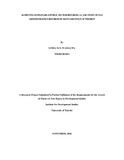| dc.description.abstract | Reforming public institutions and practices is one
subject that has attracted the attention of
policy makers, practitioners and scholars in develo
ping countries, including Kenya, for many
years. Many people would like to see public sector
institutions deliver services in an efficient
and effective manner. This has resulted in growing
pressure and demand for reforms, which
in turn has led to governments introducing reforms
aimed at improving public institutions.
Many public sector reforms have failed due to corru
ption, poor services and poor
infrastructure. However, some public sector reforms
have succeeded. Tax administration
reforms in Kenya are one of those that have succeed
ed. The implementation of tax reforms -
either at a policy or design and administration lev
el - has had its share of challenges.
Nonetheless, the results are positive. Revenue incr
eased from Kshs. 480bn in 2008 to Kshs.
635bn in 2012. This study seeks to find out why tax
administration reforms by Kenya
Revenue Authority succeeded.
The focus of the study is on Integrated Tax reforms
(iTax). The study notes that within
government, an interaction of political and economi
c motives affects the context in which
reforms take place. There are interests and incenti
ves of different stakeholders that affect
reforms and policies. Public sector reforms are lin
ked to political institutions and therefore
the political context in which they are undertaken
matters.
The study draws the following key conclusions based
on the findings. For any public sector
reform to be successful, it has to be viewed as a p
rocess rather than a one-time event. Second,
there is need for establishment of an autonomous or
semi autonomous body to govern the
process. Third, that financial resources to support
the reforms and stakeholders overall
influence, ultimately determine the success of the
public sector reforms. The analysis
revealed that the likelihood of success may be high
where the interests of all stakeholders
converge with limited and powerless stakeholders wi
th conflict of interest.
Moreover, actors
involved in public sector reforms should conduct pa
rticipatory strategic planning, application
of technology and continuous research for further i
mprovement. Ultimately, the study
established that the iTax reform, which resulted in
increased tax revenue, was a sequence of
events that were done successfully. | en_US |

